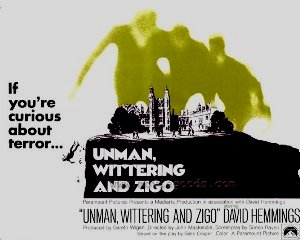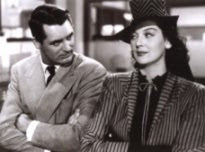Old movies, because of what they are, serve as their own documentations. If one is curious about a certain title – or about a performance in it – there’s no reason to resort to archival materials or to research what was written about the film at the time of its release.
As wonderful as it is to peruse the vintage reviews of critics Stanley Kaufmann, Pauline Kael, James Agee, Manny Farber, Dwight MacDonald, Graham Greene and Andrew Sarris, the fact is, one simply has to
look at the movie itself, first-hand, to form an educated opinion.
Thank God for film.
With theater, it’s different. Until recently, stage productions were not preserved on film or video (and most contemporary shows, for some bizarre, short-sighted reason, still aren’t). A reputedly legendary theater performance would die when the show folded and, consequently, all that’s left of stage hits from 50 or so years ago – Broadway’s celebrated Golden Era – are the dim memories of the remaining few people who saw them.
I bring up this contrast because, in a depressingly routine piece in today’s New York Times, titled
“Singing! Dancing! Adapting! Stumbling!,” second-string theater critic Charles Isherwood continues the legend of just how great Ethel Merman was in the original 1959 production of “Gypsy.”
Isherwood flat out states that it was a “fatal” decision not to cast Merman in a film version of the show – “fatal” being an awfully dramatic adjective even for an excitable theater critic to bandy about so freely.
But wait.
Exactly how does Isherwood know that Merman was great? Is he basing his opinion solely on the creaky old Columbia original-cast recording? He certainly didn’t see the original 1959 production. He couldn’t have: My references show Isherwood being born in
1964, five years after “Gypsy” opened and closed on Broadway. (Ben Brantley, the Times' chief theater critic, was only five when "Gypsy" opened.) No, Isherwood's comment is based strictly on Broadway folklore, dusty opinions handed down from generation to generation and most likely distorted with each passing.
It’s
hearsay - hearsay written with authority, albeit empty authority. And I’m not sure that hearsay, repeating an old opinion, has a valid place in an essay trying to pass itself off as original critical analysis.
Hearsay comes cheap.

At the risk of seriously dating myself here, I happened to actually see the original Broadway production of “Gypsy” – it was my first Broadway show – and have memories of Merman as a loud, forceful singer but a rather indifferent, aggressive, although not-altogether-unpleasant actress.
For some reason, the word “overrated” comes to mind.
Except for a few solipsistic theater types, I doubt if anyone seriously thinks that Merman could have carried a film of “Gypsy.” I’d be willing to wager that even Ethel herself was realistic enough to know that it would never happen, her film work being generally uneventful up to that time.
Exacerbating this matter, the Times TV section ran the following unsigned opinion when Turner Classics recently aired Warners’ 1962 version of “Gypsy”: “Russell can’t touch Broadway’s Merman.” Wanna bet that this anonymous Times writer didn’t see the original stage production either?
Hearsay. It’s all hearsay. And it’s ... worthless.
Much more worthwhile would be an analysis of why "Gypsy" has never been particularly popular with the general public. True, critics and theater aficionados love it, and gay men adore it, but the fact remains that it has never enjoyed a long run in any of its various incarnations.
Even such lesser shows as "Beatlemania" and 1989's all-but-forgotten "Grand Hotel" had longer runs. The public likes "Gypsy" alright but it also seems to keep it at arm's length, rather cautiously. Let's just say that, to Middle America, it's no "Phantom of the Opera."
The Russell referred to in that Times TV quote is, of course, Rosalind Russell, who gave a nuanced, fully-realized performance in the film. In a way, the Times is right, in spite of itself: Russell can’t touch Merman. That’s because she’s way ahead of Merman in the role. Russell’s better.
To paraphrase what I said earlier, we can’t go back and evaluate Merman’s performance. We can only read tattered, yellowed old reviews. But Russell’s performance on film – and on video and DVD – speaks for itself. It’s there to see and to savor. We don’t need hearsay.
We can see for ourselves that she's actually very good in the film.
Incidentally, Russell, who sang in “Wonderful Town” on Broadway just a few years earlier, couldn’t meet the demands of the Jule Styne-Stephen Sondheim score, and the great Lisa Kirk was brought in to dub most of the songs. The vocal match-up remains uncanny. And one more thing: The late, husky-voiced Kirk, with her driving, razor-sharp delivery, is inarguably the definitive interpreter of the Styne-Sondheim songs – better than Merman and, yes, way better than (dare I say it?) Patti Lupone.
I’m curious. What do you think of critics clinging to hearsay in reviews, giving the impression of having seen something that they, well, haven't?
It’s a habit I personally find hugely deceptive and vaguely disreputable.
But critics do it all the time. I mean, Peter Bogdanovich’s exquisite
"At Long Last Love" is usually damned by people who haven’t seen it, who have only heard about it - although it
does have a loyal
following.
Note in Passing: BTW,
the Times piece that inspired this post is one of those journalism perennials - in this case, a critic’s self-debate about the pros and cons of stage musicals and their film versions.
Am I imagining things or is this the umpteenth time that New York’s paper of record has wasted precious news space on this subject? It seems every time a new film musical is released, this standard piece is hauled out.
Anyway, reading it – or
trying to read it – I was reminded of a weary old whore tired of using the same dated tricks on her johns. Flailing around for a hook this time out, the Times uses the occasion to trash, once again, the new movie version of
“Mamma Mia!,” one of its film critics already having had a go at it. But the Times isn’t alone here. No, critics in general have been disproportionately enraged by "Mamma Mia!"
With their noted attention to (easily-manipulated) minutia and with all the subtlety and pettiness of schoolyard bullies, America's diminished and diminishing movie critics have ganged up on this harmless, purely pleasurable film as if they were engaged in a personal fight with something the approximate size of - oh, let's see - the U.S. government.
You know, there's a reason why critics have been traditionally stereotyped as miserable people deserving of their misery.
(
Artwork: We only have dimmed memories - and old photos - of Merman in "Gypsy"; Russell, with a little help from Lisa Kirk, performs the seminal "Rose's Turn" at the conclusion of the 1962 film version)




































































